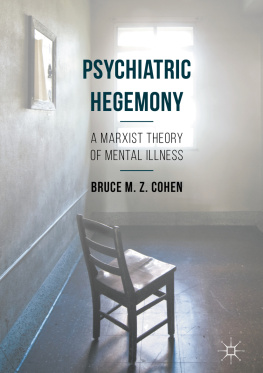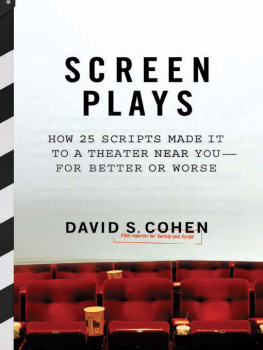Financial Crisis in American Households
The Basic Expenses That Bankrupt the Middle Class
Joseph Nathan Cohen

Copyright 2017 by Joseph Nathan Cohen
All rights reserved. No part of this publication may be reproduced, stored in a retrieval system, or transmitted, in any form or by any means, electronic, mechanical, photocopying, recording, or otherwise, except for the inclusion of brief quotations in a review, without prior permission in writing from the publisher.
Library of Congress Cataloging-in-Publication Data
Names: Cohen, Joseph Nathan, 1976 author.
Title: Financial crisis in American households : the basic expenses that bankrupt the middle class / Joseph Nathan Cohen.
Description: Santa Barbara : Praeger, [2017] | Includes bibliographical references and index.
Identifiers: LCCN 2016055250 (print) | LCCN 2017011057 (ebook) | ISBN 9781440832215 (hard copy : alk. paper) | ISBN 9781440832222 (ebook)
Subjects: LCSH: HouseholdsEconomic aspectsUnited States. | Cost and standard of livingUnited States. | Middle classUnited States. | Global Financial Crisis, 2008-2009. | HouseholdsUnited States.
Classification: LCC HC106.84 .C634 2017 (print) | LCC HC106.84 (ebook) | DDC 339.4/20973dc23
LC record available at https://lccn.loc.gov/2016055250
ISBN: 978-1-4408-3221-5
EISBN: 978-1-4408-3222-2
21 20 19 18 17 1 2 3 4 5
This book is also available as an eBook.
Praeger
An Imprint of ABC-CLIO, LLC
ABC-CLIO, LLC
130 Cremona Drive, P.O. Box 1911
Santa Barbara, California 93116-1911
www.abc-clio.com
This book is printed on acid-free paper 
Manufactured in the United States of America
For Danielle, Naomi, Maya, and Galit
Contents
Acknowledgments
I want to extend my gratitude to colleagues and friends for their help. I am deeply indebted to my mentor, Miguel Centeno, for his never-ending support. I am grateful to work with so many exceptional colleagues at Queens College, and feel a particularly deep debt to Dana Weinberg, Andrew Beveridge, and Charles Turner for their guidance, mentorship, and support. I would also like to thank Sharon Zukin, Helaine Olen and Beth Ptalis, whose early attention encouraged me to develop this project. I thank my editor, Jessica Gribble, for her valuable feedback and support. I am grateful for valuable feedback from Nathan Stein, and from the participants of panels at the Queens College Sociology Workshop, the Eastern Sociological Society, and the American Sociological Association. Finally, thank you to my family. This book is dedicated to the memory of my grandmothers, Minerva Tanner and Hazel Bright.
CHAPTER ONE
Household Financial Crisis in the United States
For years, economic analysts have spoken of a long-term decline in the economic fortunes of the U.S. middle class. Stable, well-compensated jobs are disappearing. Wages have barely paced living costs. People save less, borrow more, and go bankrupt more often than a generation ago. The ranks of the middle class in the United States are said to be emptying out
For years, many experts treated this sense of middle-class decline with some degree of credulity. They maintained that regular Americans living standards had never been higher. Upward mobility partly explained the middle classs disappearance. People have never been so well fed, enjoyed so many amenities, received so much education and healthcare, and lived so long. Our streets have never been safer. Obesitynot starvationis the principal nutritional problem facing the poor. Critics often rejected talk of a declining middle class as an exaggeration.
The 2016 U.S. presidential elections made it clear that the voting public did not agree. There appeared to be a strong, widespread sense that the U.S. economy was not serving regular Americans well. Both political parties seemed to be running against American capitalism. Economic policies that once would have been celebrated as responsive to business and in accordance with modern economic theory were now painted as part of a corrupt conspiracy against families. There seemed to be a strong, bipartisan demand that politicians find ways to protect people from an economy that seems to offer little promise for a better future.
Most families have little to nothing saved for retirement. Many of them dont have enough saved to cover a missed paycheck and dont know anyone who could lend them a few thousand dollars if they found themselves in a bind. Being short on money is a particularly serious problem in the United States, where running out of cash can endanger a persons access to healthcare, education, and work opportunities. The public institutions that might have helped compensate for these changes are widely seen as deteriorating under long-term neglect.
When discussions arise regarding the money problems faced by U.S. households, attention immediately turns to earnings problems. Explanations focus on the problems people face in getting money: income volatility, job precariousness, the decline of unions, income stagnation, and so on. Less attention is paid to the role of spending. In part, spending is not a focus because living costs are presumed to have been falling. In an era of $1 restaurant hamburgers, $50 Walmart touchscreen tablets, $12 Costco jeans, or free online newspapers and telephone calls, it makes sense to pay less attention to the role that living costs play in sowing money problems.
We should not ignore overspending, however. It is partly responsible for many Americans financial problems. Even though incomes have stagnated for years, the presumption is that families could have kept saving by tightening their belts. Although it has never been easier to cut spending, people just havent been doing it. Spending has continued to grow as it did during the golden age of the U.S. middle class in the mid-20th centuryeven if income has not.
This observation can lead many to conclude that Americans money problems are the product of personal failures. They see growing household spending as the result of the United States culture of consumerism, impulse control problems, gluttony, financial imprudence, or some other character flaw. In turn, this portrayal can foster an attitude that is more opposed to using public resources or regulation to help those with money problems. After all, if peoples excessive lifestyle expectations or inability to exercise self-control is the cause of their money problems, wouldnt subsidizing their excess consumption be wasteful and unfair to those who manage their money well? Wouldnt people be more likely to correct their bad behavior if they were exposed to its natural consequences? Moreover, wouldnt these kinds of government intrusions in the free market ultimately undermine capitalisms capability to raise living standards by creating more, better, and cheaper products?
Although there are kernels of truth to this view, it also has a very critical weakness. Roughly ten years ago, research by then-Harvard law professor (and now U.S. senator) Elizabeth Warren and colleagues found that families facing bankruptcy had fallen into trouble in part because they had difficulty keeping up with more basic expenditures, such as housing or medical care. This book presents a range of analyses suggesting that, a decade later, these spending pressures still drive the bulk of rising household spending, and they may have gotten worse. It is not that Americans are frittering away their savings on frivolous consumerism, but rather that the rising costs of key basic necessities (e.g., education, child care, or housing in nondistressed communities with access to jobs) have been spiraling upward. Moreover, these costs have risen during a period in which these necessities are become more essential to securing income. With the passage of time, sustaining a household without these types of basics is becoming more difficult.
Next page














